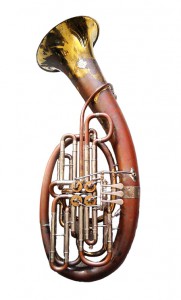 The 1960s brought a sea change for the Wagner tuba as four leading composers chose to give the instrument a significant role in important works: Friedrich Cerha (b. 1926), in ‘Mouvements I-III’ for chamber orchestra; Einojuhani Rautavaara (b. 1928), in his Third and Fourth Symphonies (1961, 1962), ‘Kaivos’ (1963) and ‘Angels and Visitations’ (1978); Bernd Alois Zimmermann (1918-70) in ‘Die Soldaten’ (1958-60); and Hans Werner Henze (b. 1926) in ‘Das Floss der Medusa’ (1968, rev. 1990).
The 1960s brought a sea change for the Wagner tuba as four leading composers chose to give the instrument a significant role in important works: Friedrich Cerha (b. 1926), in ‘Mouvements I-III’ for chamber orchestra; Einojuhani Rautavaara (b. 1928), in his Third and Fourth Symphonies (1961, 1962), ‘Kaivos’ (1963) and ‘Angels and Visitations’ (1978); Bernd Alois Zimmermann (1918-70) in ‘Die Soldaten’ (1958-60); and Hans Werner Henze (b. 1926) in ‘Das Floss der Medusa’ (1968, rev. 1990).
There followed a rebirth of composing interest, and in the last third of the twentieth century the Wagner tuba had been used by Michael Horwood (b. 1947) in his Third Symphony, Andromeda (1996), Jens-Peter Ostendorf (b. 1944) in his ‘Chor fur Orchester’ (1974), Alfred Reed in his “Theme” from ‘In Memoriam’ (1971), Will Eisma (b. 1929) in his ‘Vanbridge Concerto’, Eberhard Eyser (b. 1932) in his ‘Tornadas’, Siegfried Borris (1906-87) in his ‘Musik fur Waldhorn’ Op 109 Book 3, No. 4, Charles Shere (b. 1935) in his ‘Small Concerto for piano and orchestra’ (1964), ‘Night-music’ (1967) and ‘Tongues’ (1978), Christopher Rouse in his Symphony No. 1 (1986), Sofia Gubaidulina (b. 1931) in her ‘Viola Concerto’ (1997), Thomas Goss (b. 1962) in his ‘Uriel’s Flame’ (2000) and ‘The 7 Deadly Sins (of a dog)’ (2002).
Stephen Caudel’s Edel Rhapsody for Wagner Tuba and small orchestra (1993) is the first and only work ever to feature the instrument in a solo role with orchestra.
Perhaps the most prolific composer for Wagner tuba is the Cuban George Lopez who composed a remarkable eleven works for Wagner tuba including ‘Gonzales the Earth Eater for Solo Wagner Tuba and Four Instruments’ (1996) and ‘Dome Park for 82 Instrumentalists’ (1993) which includes 8 Wagner tubas (four in B-flat and four in F).
From the sixties onwards the instrument reached Hollywood and even the Motown charts. The Wagner tuba was memorably used in Harry Nilsson’s ‘Everybody’s Talkin’, Mason Williams’ ‘Classical Gas’ and Mike Post’s ‘Rockford Files Theme’ – the latter two being honoured with musical awards. The Wagner tuba has been used creatively in both Jazz and motion film scores.
The general impression of the Wagner tuba that is still current is of an outdated museum piece, and it is often the butt of caricature. Many hornists also have a problematical relationship with the instrument and do not normally like to play them. The Wagner tuba has a negative reputation of being hard to play and having intonational difficulties, but this stems purely from unfamiliarity with the instrument which can be the result of infrequent usage.
The one-time dearth of mid-twentieth century instrument makers has now been turned around and there are currently fifteen manufacturers of the Wagner tuba. Of these, Gebr. Alexander in Mainz are the longest continuous manufacturer. Additionally there are three manufacturers of mutes for the Wagner tuba.
Compensating double tubas were reintroduced in the 1960s, to be followed by full double tubas, yet these instruments have not been accepted without criticism.
At the start of the 21st century, inclusion of the Wagner tuba in the orchestra shows no sign of waning. Sofia Gubaidulina wrote a ‘St John’s Passion’ in 2000, Gavin Bryars (b. 1943) an opera called ‘G’ in 2002, Esa-Pekka Salonen (b. 1958) the orchestral work ‘Insomnia’ in 2002, Heinz Karl Gruber (b. 1943) the orchestral work ‘Dancing in the Dark’ (2003), and Klaus Lang (b. 1971) the opera ‘Die Perser’ (2003). Each of these compositions include Wagner tubas in their scores.